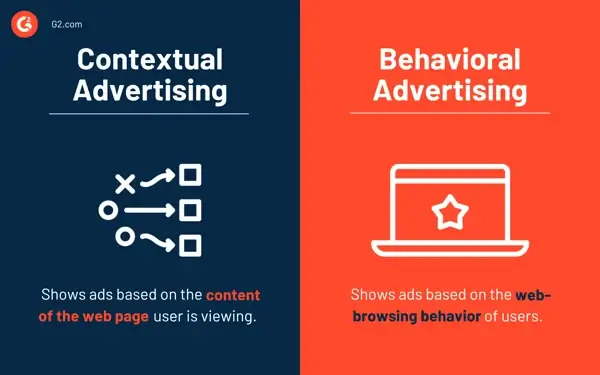It is not surprising that for proper marketing, it is essential to reach the right audience at the right moments. Therefore, contextual advertising was introduced, as a more personalized way of advertising based on user behavior while online. This way, based on data related to the location, time, patterns in surfing the web, as well as things bought previously, marketers can make particular promotional messages.
This article dives into the importance of contextual advertising and ways to use contextual data to improve advertising campaigns, leading to better outcomes in the digital market.
In this blog, we’ll cover:
- What is Contextual Advertising?
- Examples of Contextual Advertising Platforms
- Types of Contextual Advertising
- The Importance of Relevance
- Timing is Everything
- Targeting the Right Audience
- Leveraging Contextual Data
Let’s get started!
What is Contextual Advertising?
Contextual Advertising is a form of targeted marketing in which ads are displayed depending on what people are viewing presently on the web page or what they do on the internet. The advertisements are custom-made to reflect what is happening to the person at that time and suit his preferences or necessities by giving data on relevant topics. This way, they see more helpful adverts that are also likely to capture their attention, thereby enhancing user engagement levels during browsing sessions, among other things.
Contextual advertising is different from other types of advertising like behavioral targeting and demographic targeting:
- Behavioral targeting involves several aspects of understanding individuals’ preferences, such as online trends. This data includes sites’ pages visited, and specific searches performed on websites, among others. So, this technology can serve as a basis for future predictions about user behavior since it helps in foreseeing patterns that direct them to take action. However, contextual advertising relies mostly upon whatever information there is at the moment, regardless of previous behaviour.
- Demographic targeting means dividing audiences into categories based on age, gender, income, location and other criteria. This means that ads would only be served to groups that best suit the advertiser’s objectives. Contextual advertising shows messages to people based on the content they’re seeing. It doesn’t matter what their socio-economic status or background is.
In contrast to other advertising, such as behavioral targeting or demographic targeting, which depends on user data and profiles, contextual advertising looks at the immediate situation in which an individual is using the internet.
This strategy has become more popular in 2024, following the latest trends in digital advertising that focus on delivering personalized and timely messages to individuals according to their current online behaviors and preferences.
Examples of Contextual Advertising Platforms
Some common contextual advertising platforms include Google Adsense, Media.net, and Amazon Advertising. They look into the keywords or content on a webpage and then display ads that match well with the individual browsing it.
Google AdSense
Google AdSense is a contextual advertising network that lets website owners profit from displaying relevant ads. Those who wish to advertise have to compete for their place on websites in Google’s Display Network. By pasting AdSense codes into their pages, website owners enable ads pertinent to keywords and content to be displayed after the system examines them.
There are two types of payment methods that advertisers can choose to use based on their preferences. These include pay-per click (PPC) and per impression (CPM) payments. AdSense makes it simple for you to integrate it into your website by providing some straightforward code. This enhances the user experience since all adverts are placed in relation to what you write about on your site. It is possible to put textual ads and other types like texts, banners or even videos into the system using Google’s AdSense program. Moreover, publishers can access a wide network of advertisers through Google AdSense.
Media.net
Media.net focuses on contextual ads, especially native ads. When publishers use Media.net code on their website, the code looks at things like keywords and topics in the content. Native ads are smoothly integrated with the content, and publishers generate revenue through clicks or impressions. Media.net provides non-intrusive native ads that easily mix with content. Publishers can change the look of the ads to match what they want. Media.net works with the best advertisers to show users ads that are good and relevant.
Grapeshot
Now a part of Oracle, uses sophisticated AI and deep learning technology for contextual advertising. Oracle goes beyond just keywords by analyzing text, speech, custom images, and geolocation to understand context and sentiment. This allows Oracle to place relevant ads based on the content’s context, ensuring brand safety by aligning ads with the tone of the content. Furthermore, Oracle personalizes ads based on user interests, providing a more tailored advertising experience.
Types of Contextual Advertising
Contextual advertising utilizes different techniques to show ads that match the interests and needs of users according to their online behavior. Here are some common types:
Keyword Targeting
Businesses can choose a few keywords related to their products or services, and this is known as Keyword targeting. These advertisements use the chosen keywords to advertise to individuals searching for content or engaging with it.
Advertisers bid on keywords and pay when their ads are clicked or displayed. This strategy allows businesses to connect with potential customers actively interested in their offerings. Keyword targeting is commonly used in search engine marketing and pay-per-click advertising on channels like Google or Microsoft Bing. Moreover, leveraging power-words for emotional ads can significantly enhance the effectiveness of keyword targeting campaigns, evoking strong emotional responses and driving engagement.
Example: A user reading an article about making a profit on cryptocurrency may see ads about a crypto profit calculator or present value calculator later on.
Interest Targeting
This involves displaying ads to individuals based on their interests and online activities. Advertisers focus on users interested in similar products or subjects through their browsing habits, searches, or interactions with online content. This approach helps advertisers connect with a more targeted audience, improving the chances of interaction and conversions.
Example: A user is researching ways to improve non-profit management and fundraising. This user might come across ads for non-profit CRM software that helps organizations better manage their donors and operate more efficiently.
Geographic Targeting
This is a marketing technique that customizes advertisements to users’ specific locations. Marketers select the regions or countries for displaying their ads, planning to attract locals. Thus, they can customize their promotions to reach audiences in these regions where their goods are in high demand, elevating the significance of their marketing campaigns.
Example: A local restaurant would run display ads promoting its special offers only to users in the surrounding area.
The Importance of Relevance
In advertising, it is important to ensure that your ad is consistent with the material in which it is posted. Ads that fit nicely into the surrounding material are most likely to hold the eye and stimulate curiosity about the item or service being sold. By keeping relevance between the ads and the material on display, one increases the likelihood that they will reach the desired demographic and develop a thriving enterprise.
A study, conducted by GumGum and the neuroanalytics company SPARK Neuro investigated how consumers’ behavior was influenced by responsiveness to contextual information. The results are clear: advertisements placed within certain contexts receive more attention, are remembered better after a while, and create the desire for purchasing in customers. This underscores the importance of matching advertising messages with what they’re promoting. This makes it more likely that people will notice and interact with the ads.
Timing is Everything
In advertising, timing is crucial for capturing an audience’s interest and realizing the best results when they matter most. How an advertising campaign will run largely depends on how effectively marketers can send out messages right at the opportune times.
Significance of Timing in Advertising
It is essential to use time wisely for maximum effectiveness in contextual advertising. To connect with their target audience, advertisers need to understand the different times their audience is active during the day, week, and year so as to optimize the advertisement timing for maximum impact.
In the morning, coffee brands can easily target people who drink it while going to work. In the evening, however, individuals engage more with entertainment materials, so it is appropriate for movie streaming sites to advertise the latest films. Weekends are a time when travel agents can market weekend getaways. It’s also a time when companies that sell outdoor equipment can connect with sports enthusiasts.
In addition, special occasions such as Valentine’s Day present a great opportunity for flower shops to showcase discounts on loving floral arrangements. On the other hand, the start of the school year could inspire educational apps to reach out to parents with useful study tools.
By synchronizing marketing strategies with these changes in consumer habits, advertisers can attract interest and promote deeper interaction with their desired customer base.
Targeting the Right Audience
Successful ad campaigns capture your targeted audience’s attention and inspire them to take action. This can be greatly helped by contextual advertising. Contextual advertising helps narrow down service seekers who are interested in those specific goods through keywords, location, and browsing histories, among other things.
When advertisers use a targeted approach, they can make sure their ads are reaching the right audience. This increases the chances of people engaging with the ads and taking action. Contextual advertising also lets advertisers customize their messages for different audience groups on different platforms that you choose to run your ads on, making your ad campaigns even more effective. This is particularly valuable for link-building agencies who can leverage contextual advertising to promote their clients’ content to highly relevant audiences, potentially leading to more website traffic and backlinks.
Consider LinkedIn as a go-to platform for advertising as it can focus on a narrow group of specialists. Unlike other social media platforms that have a wide range of users, LinkedIn users are focused on developing their careers and networking. This means you can target your ads to specific people based on their industry, job, company size, or even particular skills.
Integrating LinkedIn ads in Google Sheets can greatly enhance audience targeting by leveraging LinkedIn’s professional data with Google Sheets’ analytical capabilities. This allows for more precise segmentation and analysis to reach the most relevant audience.
Leveraging Contextual Data
To optimize advertising campaigns, advertisers should leverage various types of contextual data:
- Location data: Ads could target specific individuals based on their current location by using ads for local events or offers. Check out Klick & Mortar geofencing options!
- Time data: Advertisers can deliver ads at the most relevant times by considering the time of day or specific moments.
- Browsing behavior: Analyzing what users have researched can help businesses understand what they find interesting. This way, they can make targeted ads from such data, hence increasing the efficiency of their marketing strategies.
- Purchase history: Utilizing data on users’ past purchases helps tailor ads to their preferences and promote relevant products or services.
- Search intent: By understanding the keywords and phrases users are searching for, advertisers can align ad content with their intent, increasing relevance.
- Device type: Considering the user’s device (e.g., desktop, mobile, tablet) allows for optimized ad formats and placements.
To effectively leverage contextual data, advertisers should:
- Conduct thorough audience research to understand their behavior and preferences.
- Continuously track and analyze data to identify patterns and trends.
- Tailor ad campaigns based on the insights gained from contextual data.
Conclusion
In conclusion, contextual advertising is a powerful tool for marketers to interact with their customer base more effectively. Once an advert has all the important details, like the current location, time when it was shown, browser history, or past buying behaviors, it becomes much more appropriate for that particular moment than ever. Ads related to people’s interests and shown at the right time make it likely for them to engage with a brand. This is because they are more relevant and timely, thus making them more attractive to the person viewing them!
Contextual advertising will yield the best results if you continue learning about your audience, analyzing data, and making the necessary adjustments. By using data about the context of your ads, your business can improve its ad campaigns, achieve better results, and reach its marketing goals.
If you’re looking to run hyper-targeted ad campaigns, contact us at War Room today.
About Guest Author
Alona Bontush is an SEO outreach specialist at Growthmate, a young and fast-developing link-building agency. She is passionate about helping businesses improve their organic search rankings and increase website traffic through strategic link-building campaigns. When it comes to outreach, she has both strong communication and persuasive conversational skills.
Socials: LinkedIn

















